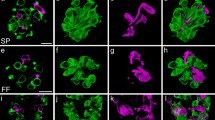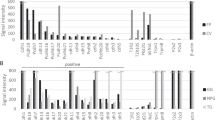Abstract
Taste buds are accumulations of elongated bipolar cells situated on lingual papillae. The factors that determine the sites where a taste bud may develop are largely obscure, although it is known that the early invasion of nerve fibers plays one of the key roles in taste bud development and maturation. The conditions under which taste bud primordium cells develop are influenced by the interaction between epithelial cells and extracellular matrix molecules of the mesenchyma, such as hyaluronan. Thus, we investigated immunohistochemically the distribution pattern of the receptor for hyaluronan, CD44s, and its epithelial variant isoforms CD44v6 and CD44v9, in taste buds of human embryonic, fetal, perinatal, and adult tongues. Furthermore, we wanted to determine the temporal and spatial relationships of CD44 to sensory innervation of taste bud primordia. In early gestational stages (weeks 7–9), CD44 and its isoforms are expressed on membranes of apical perigemmal (marginal) cells covering taste bud primordia. It seems that CD44 serves as a marker for marginal cells (perigemmal cells) in early developmental stages. The expression of CD44 follows rather than precedes the invasion of sensory nerve fibers and the development of taste bud primordia (weeks 7–8). In new-born and adult taste bud cells, only the standard molecule, CD44s, is expressed; the variant isoforms, CD44v6 and CD44v9, occur only in the adjacent epithelium. From these results it is likely that marginal cells are of the utmost importance for the development and maturation of taste buds. We presume that CD44 is involved in local binding, reuptake, and degradation of hyaluronan in the early stages of taste bud formation. CD44 probably does not induce the transformation of epithelial cells into taste bud primordial cells. What is more, CD44 may change its function in the course of developmental events.
Similar content being viewed by others
Author information
Authors and Affiliations
Additional information
Accepted: 13 January 1998
Rights and permissions
About this article
Cite this article
Witt, M., Kasper, M. Immunohistochemical distribution of CD44 and some of its isoforms during human taste bud development. Histochemistry 110, 95–103 (1998). https://doi.org/10.1007/s004180050270
Issue Date:
DOI: https://doi.org/10.1007/s004180050270




